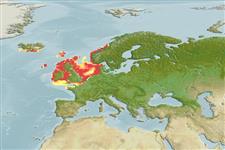Teleostei (teleosts) >
Perciformes/Cottoidei (Sculpins) >
Cottidae (Sculpins)
Etymology: Micrenophrys: Greek, mikros = small + Greek, ophrys = eye bow.
Eponymy: Wilhelm Lilljeborg (1816–1908) was a Swedish zoologist who became Professor of Zoology at Uppsala University and a member of the Swedish Academy of Science (1861). [...] (Ref. 128868), visit book page.
Environment: milieu / climate zone / depth range / distribution range
Ecology
Marine; brackish; demersal; depth range 0 - 100 m (Ref. 35388). Temperate; 66°N - 48°N, 25°W - 13°E
Northeast Atlantic: Norwegian coasts to Namdahl to off Denmark, around British Isles and across to Iceland. Pelagic larvae spreading to western Murman and Icelandic waters.
Size / Weight / Age
Maturity: Lm ? range ? - ? cm
Max length : 7.4 cm SL male/unsexed; (Ref. 4698); common length : 6.0 cm SL male/unsexed; (Ref. 4698)
Differs from Taurulus bubalis by the row of bony knobs above the rough lateral line and by the 2 soft rays in the anal fin (Ref. 35388).
Found on hard bottoms (gravel or shells) or among algae with temperatures ranging below 0°C. Feeds on small crustaceans (amphipods, decapods) and fishes. Spawns in early spring. Eggs demersal, in clumps on bottom, diameter 2 mm; larvae pelagic (Ref. 4698).
Life cycle and mating behavior
Maturity | Reproduction | Spawning | Eggs | Fecundity | Larvae
Fedorov, V.V., 1986. Cottidae. p. 1243-1260. In P.J.P. Whitehead, M.-L. Bauchot, J.-C. Hureau, J. Nielsen and E. Tortonese (eds.) Fishes of the North-eastern Atlantic and the Mediterranean. UNESCO, Paris. Vol. 3. (Ref. 4698)
IUCN Red List Status (Ref. 130435: Version 2024-1)
Threat to humans
Harmless
Human uses
Tools
Special reports
Download XML
Internet sources
Estimates based on models
Preferred temperature (Ref.
123201): 7.7 - 12, mean 10.2 °C (based on 488 cells).
Phylogenetic diversity index (Ref.
82804): PD
50 = 1.0000 [Uniqueness, from 0.5 = low to 2.0 = high].
Bayesian length-weight: a=0.00589 (0.00281 - 0.01234), b=3.15 (2.97 - 3.33), in cm total length, based on LWR estimates for this (Sub)family-body shape (Ref.
93245).
Trophic level (Ref.
69278): 3.8 ±0.62 se; based on food items.
Resilience (Ref.
120179): Medium, minimum population doubling time 1.4 - 4.4 years (Preliminary K or Fecundity.).
Fishing Vulnerability (Ref.
59153): Low vulnerability (10 of 100).
Nutrients (Ref.
124155): Calcium = 145 [55, 366] mg/100g; Iron = 0.442 [0.203, 1.010] mg/100g; Protein = 17.5 [15.3, 19.7] %; Omega3 = 0.671 [0.275, 1.722] g/100g; Selenium = 5.65 [1.24, 18.26] μg/100g; VitaminA = 43.2 [13.1, 138.2] μg/100g; Zinc = 1.09 [0.67, 2.01] mg/100g (wet weight);
